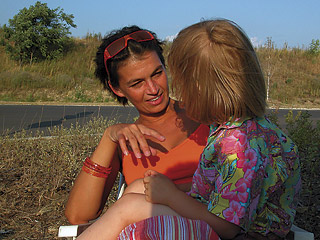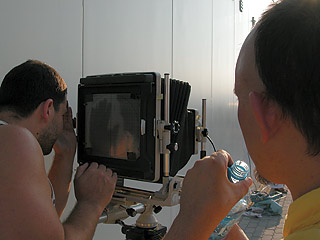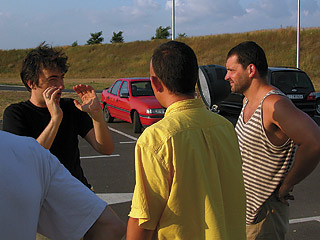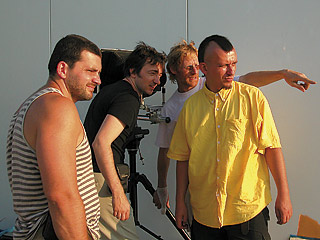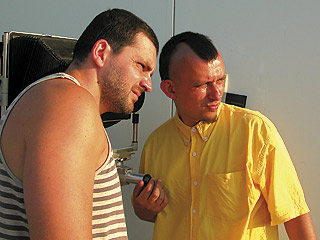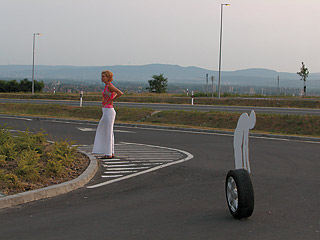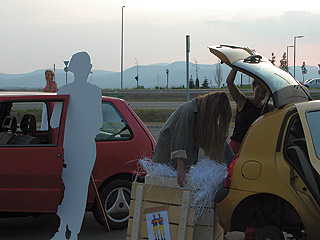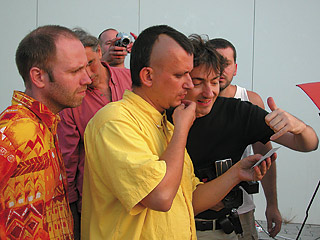|
A kortárs művészek gondolkodásmódjához általában hozzátartozik
a személyes, közvetlen tapasztalatra való refl ektálás, a hétköznapi
megfi gyelések, kis témák ikonográfi ájának kimunkálása
– ugyanakkor műveik mégis alapvetően tartózkodók, többnyire
a személyességet kerülők, stilizáltak. Ez jellemzi Gyenis Tibor és
Koronczi Endre eddigi munkáit is.
A magánélet egy-egy mozzanatának bejátszása vagy a műnek privát
dokumentumként való aposztrofálása gyakori gesztus – s a közönség
hálás is érte, hisz már évszázadok óta gyakorlat kutatni az egyes
munkák láthatón-megnevezetten túli vonásait, enigmáit.
Gyenis Tibor és Koronczi Endre éppen nem eltitkolni kíván a
Basic projektben. Elmondják a művek létrejöttének okait, bemutatják
és a művekbe bevonják elkészülésük módját, néven nevezik
a felkért résztvevőket, a mű részének tekintik az előkészítő személyes
kommunikációt.
A Basic gondolata a kiállítás előtti őszön fogalmazódott meg, egy
olyan időszakban, amikor mindkét művész élete súlyos válságba
került: megoldatlan személyes problémáik, elsősorban párkapcsolatuk
krízise, s emiatt gyerekükkel, barátaikkal újrarendeződő kapcsolathálójuk,
a napi életvitel drámai átszervezése egyfolytában a
napi munka elé tolakodott, idejük-gondolataik-fi gyelmük nagyobb
részét lekötötte. Ekkor vetődött föl: miért ne lehetne éppen azt
tematizálni, ami leginkább foglalkoztatja őket?
Az ötlet amilyen evidensnek tűnt, épp annyira kockázatos is volt.
Közvetlen módon beavatni a személyes sors apró – bár a résztvevőknek
megrázó – történéseibe a nézőt: nem válik közhelyessé,
unalmassá, mint az emberek magánélete általában a kívülállók
szemében? Mitől lesz érintetté a néző? Nem válik-e az igazmondás
hamissággá a közvetítő médium által (mint a tévében is, annyiszor)?
E kételyekre nem elegendő valami ilyesfajta válasz: de majd mi
mélységesen, végletesen őszinték leszünk! Egyrészt, mert a művészek
végülis hosszas munkával egy narratívát munkáltak ki, s a történetmondásnak,
a képalkotásnak akárhogyis megvannak a maga
szabályai, paneljei. Másrészt pedig azért lett maga az őszinteség
témává már a műkészítés első heteitől, mert a készítés folyamata
alatt a történetmondók is változtak, tovább-gördült az életük, s
ezáltal változott a történet is bennük. Sőt, maga a képkészítés is
belejátszik mindebbe: elkerülhetetlenül kimondásokra késztette
az érintetteket egymáshoz való kapcsolatukban. A művészek arra
törekedtek, hogy narratív keretbe átemeljék személyes érzésviláguk
gyakran ködös, megfogalmazhatatlannak tűnő, a kimondások
szorongásával terhelt gomolygását. A narratív keret eseménytöredékekből,
mondatokból, néha egészen közhelyes mozzanatokból
áll, amely egyértelmű, ám sokrétegű képpé fogalmazás felé törekszik. E fokozatosan fölrajzolódó tablón személyek jelentek
meg (a művésznek meg kell neveznie azokat a személyeket, akikről
azt gondolja, valóban meghatározó szerepűek, e döntés minden
érzékenységével és kockázatával), a személyek kapcsolatba kerülnek
egymással, míg össze nem áll a háttér (helyszínkeresés), s a
jelenetben helyükre nem kerülnek a szereplők (jelmezek, kellékek,
gesztustanulmányok). Mindez a fotózás előtti pillanatig az utolsó
mozzanatokig kidolgozottan él a művész képzeletében, ám maga
a képkészítés váratlan fordulatok tömegét rejti: a tervezhető,
mégis bizonytalan elemek (világítás, fotónyersanyag, díszletelemek
elmozdulása stb.) mindegyike önálló életet él, de a legsúlyosabban
tervezhetetlen „változók” maguk a szereplők, akik nem csak a
művész által rájuk ruházott szerepet játsszák, hanem szembesítik
saját történet-változatukat a szituációval.
A munka három szálon folyt. Egyrészt végig kellett gondolni, hogy
ez a megközelítés hogyan talál helyet magának a kortárs művészeti
diskurzusban. Másrészt a résztvevők felkérésével, szerepvállalásukkal
szinte óráról órára dinamikusan változott a műről való gondolkodás.
Harmadrészt azonban mindeközben meg kellett találni az alkalmas
helyszínt, megszervezni a stábot, megoldani az összes járulékos technikai
gondot. Eközben pedig ebből a számtalan változóból érvényes
és az eredeti felvetést kibontó, az összes jelentésréteget hordozó
képet szervezni, méghozzá úgy, hogy mindezen megfontolásokból és
történésekből majd a néző is átélhető módon részesüljön.
Az eredmény pedig sajátos műfajú kép lett: pszichotabló.
A pszichotabló bár egyetlen beállítást, egyetlen pillanatot rögzít,
több időrétegre is rátekint. Az a „kép”, amelyet látvánnyá fogalmaz,
egyfelől a „felismerés” utólagosságából, rátekintő módjából szemlél
(amikoris rádöbbenünk: ez volt életünk egyik fordulópontja), másfelől
a jelenből rekonstruál egy pszichológiailag létező („úgy éreztem,
magam, mint akit…”), ám eseményszinten persze meg nem történt
„eseményt”. A rekonstrukció pedig számos korábbi időréteget „terít”
egymásra, apróbb történések, drámai pillanatok és csak utólag jelentéssel
telítődő gesztusok gyűlnek egybe a „döntő pillanat” személyes
víziójában. A pillantás arra a múltbeli képre vetül, amelyben megfogalmazhatóvá
válik a jelen meggondolásainak motivációja, oka,
indítéka. A kép, bár első látásra jól értelmezhető jelenetté állt össze,
ugyanakkor a képiség hagyományainak többolvasatúságán alapszik,
jelenkori helyszínen is archetipikus elrendezettségű, a pszichológiai
folyamatokra referál, képi hagyományokat idéz. |
The mentality of contemporary artists is usually characterized by
refl ection on direct personal experience and by processing the
iconography of everyday observations and small-scale themes. At the
same time, however, the works themselves are fundamentally reserved;
most often they are stylized and avoid intimacy. As is true of the works of
Tibor Gyenis and Endre Koronczi to date.
Displaying moments from someone’s private life or calling a work a private
document are frequent gestures—and the viewers are grateful for them,
because for hundreds of years there has existed the practice of looking for
features in a particular work that are beyond the realm of the visible and
nameable—pointing out its enigmas.
Tibor Gyenis and Endre Koronczi do not wish to hide anything in
Basic Project. They disclose the reasons why the pieces were created,
they reveal, and involve in the works, the methods of creation, they name
the participants and consider any personal communication in preparation
for the work an integral part of the artwork.
The concept of Basic was formulated in the autumn preceding the launch
of the exhibition, in a period when the lives of both artists were in peril:
their unsolved personal problems, primarily the crisis of their relationships
and the reorganized social networks including their children and friends,
the dramatic rearrangement of their routine tasks constantly got in the
way of their daily work, draining away most of their time, thought, and
attention. This was the moment when it occurred to them: what if they
thematized the issues that are on their minds?
The idea was as risky as it was self-evident. To directly let viewers in on the
small—although for the participants shocking—secrets of a life: would
it not become commonplace or boring, similarly to people’s private lives
to the eyes of outsiders? How can the viewer be emotionally involved?
Would not truthfulness turn into insincerity through the medium (like it
often happens on TV)?
Doubts such as these cannot be dispelled by the following answer: we
will be profoundly, extremely honest! For one thing, artists actually
develop narratives through a tedious work process, and storytelling and
imagery have their own rules On the other hand, honesty itself became
a subject matter in the early weeks of the creation process because even
the storytellers changed on the way, their lives rolled on, and accordingly
the story within them changed, too. What is more, image-making
played a part: it made the participants reveal their feelings about their
relationships. The artists strove to provide a narrative for the often foggy
and apparently unsayable chaos of their personal emotions burdened
with the anxiety of revelations. This narrative frame contains fragments
of events, sentences, sometimes utterly commonplace moments, which,
however, aspire to defi nition as an evident but multi-layered image. On
this gradually evolving tableau diff erent persons appeared (the artist must names those persons they attribute determinant roles to, in full
knowledge of the sensitivity and threats of such a choice), these people
then interact with one another until the backdrop (the search for a
location) is established, and the characters fi nd their places in the scene
(costumes, props, gesture studies). All this lives elaborately in the mind of
the artist at the moment preceding the shot, down to the last detail, yet
the process of taking the picture itself is exacerbated by a multitude of
twists and turns: the plannable, insecure elements (lighting, raw materials
for photography, moving props, etc.) all live their own life, but the most
severely incalculable “variables” are the characters themselves, who not
only play the roles bestowed on them by the artist, but also collate their
own reading of the story with the situation.
The work was threefold: fi rst, the artists had to fi nd a place for this
approach in the discourse of contemporary art. Second, with the help of
invited responses from the participants, with their undertaking the roles,
thought about the work changed almost hourly. Thirdly, they had to fi nd a
suitable location, organize the crew, solve all of the ancillary technological
problems. In the meantime, however, a valid image had to be organized
out of the many variables, an image that would extrapolate from the
original idea and still bear all the layers of meaning, in a way that the
viewer can also profi t from and experience these refl ections and actions.
The end result was an image of a special genre: the psychotableau.
Although the psychotableau records a single shot, a single moment,
it off ers a view of several layers of time. The “image” that it turns
into a spectacle presents, on the one hand, the subsequent and
contemplative point of view of “recognition” (when we suddenly realize
that the moment we have just experienced was a major turning point
in our lives); on the other, it reconstructs a psychologically existing
“event” from the standpoint of the present (“I felt like I was…”), which
nonetheless did not exist as an event then, of course. This process
of reconstruction lays several time strata on one another; smaller
occurrences, dramatic moments, and gestures only subsequently
fi lled with meaning all coalesce in the personal vision of the “decisive
moment.” The gaze is projected onto a past image in which the motives,
causes, and reasons of present decisions can be articulated. The image
appears to have come together as a well interpretable scene at fi rst
glance, but in reality it is based on the possibility to off er multiple
interpretations of the traditions of the image; it has an archetypal
arrangement even if it shows a contemporary location, and it relates to
psychological processes, evoking conventions of the image. |
Basic projekt bibliográfia
Dokumentumok
Bán András: Felkérőlevél a részvételre
Bán András: Projektleírás
Gyenis Tibor: A werkfilm szövege
Gyenis Tibor – Koronczi Endre: A megnyitón elhangzott szöveg
Koronczi Endre: A werkfilm szövege
Reflexiók
Aknai Katalin: A kentaur lova. Basic projekt.
Gyenis Tibor – Koronczi Endre kiállítása. Műértő, 2004. szept.
András Edit: Kulturális átöltözés. Művészet a szocializmus romjain.
Budapest, Argumentum, 2010.
Beck András – Eperjesi Ágnes: 2 levél 2x2 műről,
Balkon, 2004/9. 42-44. o.
Gyenis Tibor: Válaszlevél Beck Andrásnak és Eperjesi Ágnesnek.
Balkon, 2004. 09.
Hock Bea: Intellektuális erotika. in: uő.: Nemtan és pablikart.
Lehetséges értelmezési szempontok az utóbbi másfél évtized két
művészeti irányzatához. Prasens Kiadó, Budapest, 2005.
Hock Bea: Intellektuális erotika. Prasens, 2004. ősz
Mélyi József: Művészeti önterápia. exindex.hu,
2004. szeptember 27.
Somogyi Zsófi a: Mély játék. Gyenis Tibor – Koronczi Endre: Basic.
Kállai Ernő művészettörténészi, műkritikusi ösztöndíj –
III. Beszámoló. 2009. Kézirat.
Somogyi Zsófi a: Mély játék: Gyenis Tibor – Koronczi Endre: Basic.
Fotóművészet, 2010 / 4.
Tuczai Rita: A Basic Project és a performatív működés.
Performance – performáció – performativitás – workshop.
Modernitás Kultúratudományi PhD Program Műhelye, Pécs, 2007.
Tuczai Rita: A Basic projekt mint emlékezet-konstrukció.
(Pszichotablók). Magyar Lettre Internationale 64.
Tuczai Rita: A nő mint idegen – egy kortárs művészeti project.
A kulturális másság reprezentációi – A Magyar Kulturális
Antropológiai Társaság vándorkonferenciája I.,
Miskolc-Egyetemváros, 2007.
Zalka Zsolt: Basic fault. Lélektani konzílium a Basic projekthez.
2004. Kézirat. |

